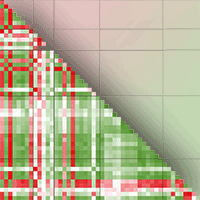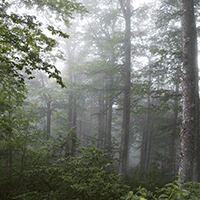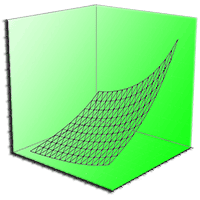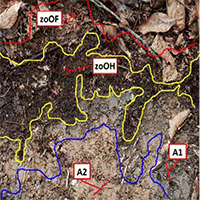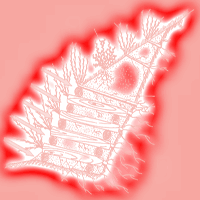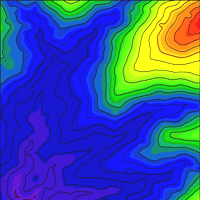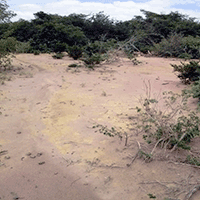Understanding the effects of silvicultural practices including single-tree selection on soil properties is essential for forest management in temperate broadleaved beech forests. Changes in physico-chemical and biological soil properties in 15 harvest-created gaps under single-tree selection and the adjacent closed canopies, with five replications for each, were studied 6 years after gap creation in an oriental beech (Fagus orientalis L.) stand of the Hyrcanian forest. Gaps were classified into three size classes: small (85-130 m2), medium (131-175 m2) and large (176-300 m2). Soil cores were collected at the center and at the edge of gaps, and under the adjacent closed canopy. Results indicated that gap size significantly affected soil texture and bulk density, whereas soil organic carbon (SOC), total nitrogen and pH showed a significant gradient from the center to the edge of gap independently form their size. SOC and total nitrogen at the center of gaps were also significantly lower than closed-canopy, in particular for the medium-gap; contrastingly, the bulk density with the highest mean value was found at the center of the large-gap. Gap size had no significant influence on soil microbial biomass. These results highlighted that similar conditions in terms of many soil properties were still present among gaps and adjacent closed-canopy stands six years after logging, though canopy openness triggered a reduction in carbon and nitrogen availability along with the related microbial activity at the center of gaps, independently from their size. Therefore, if aimed at preserving an uneven aged structure along with soil quality in temperate broadleaved deciduous forest as the oriental beech stands in the Hyrcanian region, single-tree selection practice for harvesting trees can be recommended as sustainable forest management type.
Keywords
, , ,
Citation
Amolikondori A, Abrari Vajari K, Feizian M, Di Iorio A (2020). Influences of forest gaps on soil physico-chemical and biological properties in an oriental beech (Fagus orientalis L.) stand of Hyrcanian forest, north of Iran. iForest 13: 124-129. - doi: 10.3832/ifor3205-013
Academic Editor
Giorgio Alberti
Paper history
Received: Jul 30, 2019
Accepted: Jan 25, 2020
First online: Apr 07, 2020
Publication Date: Apr 30, 2020
Publication Time: 2.43 months
© SISEF - The Italian Society of Silviculture and Forest Ecology 2020
Open Access
This article is distributed under the terms of the Creative Commons Attribution-Non Commercial 4.0 International (https://creativecommons.org/licenses/by-nc/4.0/), which permits unrestricted use, distribution, and reproduction in any medium, provided you give appropriate credit to the original author(s) and the source, provide a link to the Creative Commons license, and indicate if changes were made.

Breakdown by View Type
(Waiting for server response...)
Article Usage
Total Article Views: 40243
(from publication date up to now)
Breakdown by View Type
HTML Page Views: 34374
Abstract Page Views: 2936
PDF Downloads: 2245
Citation/Reference Downloads: 5
XML Downloads: 683
Web Metrics
Days since publication: 2082
Overall contacts: 40243
Avg. contacts per week: 135.30
Article Citations
Article citations are based on data periodically collected from the Clarivate Web of Science web site
(last update: Mar 2025)
Total number of cites (since 2020): 9
Average cites per year: 1.50
Publication Metrics
by Dimensions ©
Articles citing this article
List of the papers citing this article based on CrossRef Cited-by.
(1)
Adachi M, Bekku YS, Rashidah W, Okuda T, Koizumi H (2006)Differences in soil respiration between different tropical ecosystems. Applied Soil Ecology 34: 2-3.), 258-265.
CrossRef |
Gscholar
(2)
Alef K, Nannipieri P (1995)Methods in applied soil microbiology and biochemistry. Academic Press, London, UK, pp. 576.
Gscholar
(3)
Al-Shammary AAG, Kouzani AZ, Kaynak A, Khoo SY, Norton M, Gates W (2018)Soil bulk density estimation methods: a review. Pedosphere 28 (4): 581-596.
CrossRef |
Gscholar
(4)
Arunachalam A, Arunachalam K (2000)Influence of gap size and soil properties on microbial biomass in a subtropical humid forest of north-east India. Plant and Soil 223 (1-2): 187-195.
CrossRef |
Gscholar
(5)
Bolat I (2014)The effect of thinning on microbial biomass C, N and basal respiration in black pine forest soils in Mudurnu, Turkey. European Journal of Forest Research 133 (1): 131-139.
CrossRef |
Gscholar
(6)
Bouyoucos GJ (1962)Hydrometer method improved for making particle size analysis of soils. Agronomy Journal 54 (5): 464-465.
CrossRef |
Gscholar
(7)
Brookes PC, Powlson DS, Jenkinson DS (1982)Measurement of microbial biomass phosphorus in soil. Soil Biology and Biochemistry 14 (4): 319-329.
CrossRef |
Gscholar
(8)
Brookes PC, Landman A, Pruden G, Jenkinson DS (1985)Chloroform fumigation and the release of soil nitrogen: a rapid direct extraction method to measure microbial biomass nitrogen in soil. Soil biology and biochemistry 17 (6): 837-842.
CrossRef |
Gscholar
(9)
Chandra LR, Gupta S, Pande V, Singh N (2016)Impact of forest vegetation on soil characteristics: a correlation between soil biological and physico-chemical properties. 3 Biotech 6 (2): 188.
CrossRef |
Gscholar
(10)
Chaouqi N, El Gharous M, Naceri Bouzziri Z M (2017)A simplified method for laboratory soil analysis. International Journal of Geomate 12 (34): 76-81.
CrossRef |
Gscholar
(11)
D’Oliveira MV, Ribas LA (2011)Forest regeneration in artificial gaps twelve years after canopy opening in Acre State Western Amazon. Forest Ecology and Management 261 (11): 1722-1731.
CrossRef |
Gscholar
(12)
Joergensen RG, Mueller T (1996)The fumigation-extraction method to estimate soil microbial biomass: calibration of the kEN value. Soil Biology and Biochemistry 28 (1): 33-37.
CrossRef |
Gscholar
(13)
He Z, Liu J, Wu C, Zheng S, Su S, Wu C (2012)Effects of forest gaps on some microclimate variables in
Castanopsis kawakamii natural forest. Journal of Mountain Science 9 (5): 706-714.
CrossRef |
Gscholar
(14)
Kooch Y, Hosseini SM, Mohammadi J, Hojjati SM (2010)The effects of gap disturbance on soil chemical and biochemical properties in a mixed beech-hornbeam forest of Iran. Ecologia Balkanica 2: 39-56.
Gscholar
(15)
Latif ZA, Blackburn GA (2010)The effects of gap size on some microclimate variables during late summer and autumn in a temperate broadleaved deciduous forest. International Journal of Biometeorology 54 (2): 119-129.
CrossRef |
Gscholar
(16)
Lewandowski TE, Forrester JA, Mladenoff DJ, Stoffel JL, Gower ST, Amato D AW, Basler TC (2015)Soil microbial community response and recovery following group selection harvest: temporal patterns from an experimental harvest in a US northern hardwood forest. Forest Ecology and Management 340: 82-94.
CrossRef |
Gscholar
(17)
Liu Y, Zhang J, Yang W, Wu F, Xu Z, Zhang L, He X, Gua L (2018)Canopy gaps accelerate soil organic carbon retention by soil microbial biomass in the organic horizon in a subalpine fir forest. Applied Soil Ecology 125: 169-176.
CrossRef |
Gscholar
(18)
Muscolo A, Sidari M, Mercurio R (2007a)Influence of gap size on organic matter decomposition, microbial biomass and nutrient cycle in Calabrian pine (
Pinus laricio Poiret) stands. Forest Ecology and Management 242 (2-3): 412-418.
CrossRef |
Gscholar
(19)
Muscolo A, Sidari M, Mercurio R (2007b)Variations in soil chemical properties and microbial biomass in artificial gaps in silver fir stands. European Journal of Forest Research 126 (1): 59-65.
CrossRef |
Gscholar
(20)
Muscolo A, Sidari M, Bagnato S, Mallamaci C, Mercurio R (2010)Gap size effects on above-and below-ground processes in a silver fir stand. European Journal of Forest Research 129 (3): 355-365.
CrossRef |
Gscholar
(21)
Olsen SR, Cole CV, Watanabe FS, Dean LA (1954)Estimation of available phosphorus in soils by extraction with sodium bicarbonate. USDA Circular 939, US Government Printing Office, Washington, DC, USA, pp. 1-19.
Online |
Gscholar
(22)
Page AL (1992)Methods of soil analysis. ASA and SSSA Publishers, Madison, WI, USA, pp. 321.
Gscholar
(23)
Pang X, Bao W, Zhu B, Cheng W (2013)Responses of soil respiration and its temperature sensitivity to thinning in a pine plantation. Agricultural and Forest Meteorology 171: 57-64.
CrossRef |
Gscholar
(24)
Papuga K, Kaszubkiewicz J, Wilczewski W, Stas M, Belowski J, Kawalko D (2018)Soil grain size analysis by the dynamometer method-a comparison to the pipette and hydrometer method. Soil Science Annual 69 (1): 17-27.
CrossRef |
Gscholar
(25)
Pujia Y, Qiang L, Hongtao J, Guangdi L, Wei Z, Xiangiin S, Baba D (2014)Effect of cultivation on dynamics of organic and inorganic carbon stock in Songnen plain. Agronomy Journal 106 (5): 1574-1582.
CrossRef |
Gscholar
(26)
Ravindran A, Yang SS (2015)Effects of vegetation type on microbial biomass carbon and nitrogen in subalpine mountain forest soils. Journal of Microbiology, Immunology and Infection 48 (4): 362-369.
CrossRef |
Gscholar
(27)
Ritter E, Bjørnlund L (2005)Nitrogen availability and nematode populations in soil and litter after gap formation in a semi-natural beech-dominated forest. Applied Soil Ecology 28 (2): 175-189.
CrossRef |
Gscholar
(28)
Ritter E, Vesterdal L (2006)Gap formation in Danish beech (
Fagus sylvatica) forests of low management intensity: soil moisture and nitrate in soil solution. European Journal of Forest Research 125 (2): 139-150.
CrossRef |
Gscholar
(29)
Saner P, Lim R, Burla B, Ong RC, Schrer-Lorenzen M, Hector A (2009)Reduced soil respiration in gaps in logged lowland dipterocarp forests. Forest Ecology and Management 258 (9): 2007-2012.
CrossRef |
Gscholar
(30)
Sariyildiz T (2008)Effects of gap-size classes on long-term litter decomposition rates of beech, oak and chestnut species at high elevations in Northeast Turkey. Ecosystems 11 (6): 841-853.
CrossRef |
Gscholar
(31)
Scharenbroch BC, Bockheim JG (2007)Impacts of forest gaps on soil properties and processes in old growth northern hardwood-hemlock forests. Plant and Soil 294 (1-2): 219-233.
CrossRef |
Gscholar
(32)
Schliemann SA, Bockheim JG (2014)Influence of gap size on carbon and nitrogen biogeochemical cycling in Northern hardwood forests of the Upper Peninsula, Michigan. Plant and Soil 377 (1-2): 323-335.
CrossRef |
Gscholar
(33)
Vance ED, Brookes PC, Jenkinson DS (1987)An extraction method for measuring soil microbial biomass C. Soil biology and biochemistry 19 (6): 703-707.
CrossRef |
Gscholar
(34)
Walkley A, Black IA (1934)Estimation of soil organic carbon by the chromic acid titration method. Soil Science 37: 29-38.
CrossRef |
Gscholar
(35)
Yamamoto SI (2000)Forest gap dynamics and tree regeneration. Journal of Forest Research 5 (4): 223-229.
CrossRef |
Gscholar
(36)
Yang K, Zhu J, Zhang M, Yan Q, Sun OJ (2010)Soil microbial biomass carbon and nitrogen in forest ecosystems of Northeast China: a comparison between natural secondary forest and larch plantation. Journal of Plant Ecology 3 (3): 175-182.
CrossRef |
Gscholar
(37)
Yang Y, Geng Y, Zhou H, Zhao G, Wang L (2017)Effects of gaps in the forest canopy on soil microbial communities and enzyme activity in a Chinese pine forest. Pedobiologia 61: 51-60.
CrossRef |
Gscholar
(38)
Zhang C, Zhao X (2007)Soil properties in forest gaps and under canopy in broad-leaved
Pinus koraiensis forests in Changbai Mountainous region, China. Frontiers of Forestry in China 2 (1): 60-65.
CrossRef |
Gscholar


